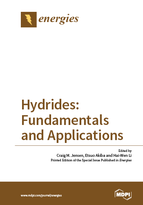Hydrides: Fundamentals and Applications
A special issue of Energies (ISSN 1996-1073).
Deadline for manuscript submissions: closed (15 July 2015) | Viewed by 114921
Special Issue Editors
Interests: catalysis; reaction mechanisms; NMR spectroscopy; hydrogen storage materials
Interests: Materials Science, Hydrogen Energy, Crystal Structure Analysis
Interests: hydrogen storage; hydrogen energy; hydride; rechargeable battery materials
Special Issues, Collections and Topics in MDPI journals
Special Issue Information
Dear Colleauges,
The reversible elimination of hydrogen from metal hydrides serves as the basis for unique methods of energy transformation. This technology has found widespread practical utilization in applications such as hydrogen compressors, storage, and sensors, as well as batteries. Moreover, it is plausible that metal hydride technology could be utilized to provide practically viable solutions to the challenges of energy storage. For nearly two decades, an extensive, worldwide research effort has been devoted to complex metal hydrides possessing high volumetric and/or gravimetric hydrogen densities with the goal of their practical utilization as onboard hydrogen storage materials. Additionally, a significant and growing number of efforts have been devoted to developing metal hydrides as advanced sensors and ionic conductors, and for electrochemical and stationary energy storage. This Special Issue will provide a sampling of on-going, state-of-art research on metal hydrides, ranging from fundamental investigations to practical applications with a concentration on topics which are currently of high interest.
Prof. Dr. Craig M. Jensen
Prof. Dr. Etsuo Akiba
Associate Prof. Dr. Hai-Wen Li
Guest Editors
Manuscript Submission Information
Manuscripts should be submitted online at www.mdpi.com by registering and logging in to this website. Once you are registered, click here to go to the submission form. Manuscripts can be submitted until the deadline. All submissions that pass pre-check are peer-reviewed. Accepted papers will be published continuously in the journal (as soon as accepted) and will be listed together on the special issue website. Research articles, review articles as well as short communications are invited. For planned papers, a title and short abstract (about 100 words) can be sent to the Editorial Office for announcement on this website.
Submitted manuscripts should not have been published previously, nor be under consideration for publication elsewhere (except conference proceedings papers). All manuscripts are thoroughly refereed through a single-blind peer-review process. A guide for authors and other relevant information for submission of manuscripts is available on the Instructions for Authors page. Energies is an international peer-reviewed open access semimonthly journal published by MDPI.
Please visit the Instructions for Authors page before submitting a manuscript. The Article Processing Charge (APC) for publication in this open access journal is 2600 CHF (Swiss Francs). Submitted papers should be well formatted and use good English. Authors may use MDPI's English editing service prior to publication or during author revisions.
Keywords
- metal hydride
- complex hydride
- hydrogen storage
- hydrogen sensor
- electrochemical application
- ionic conductors
- energy storage








